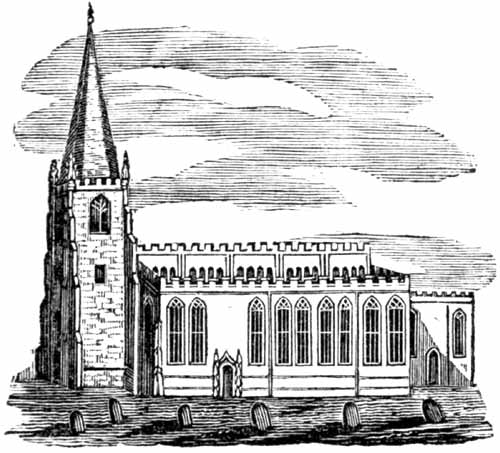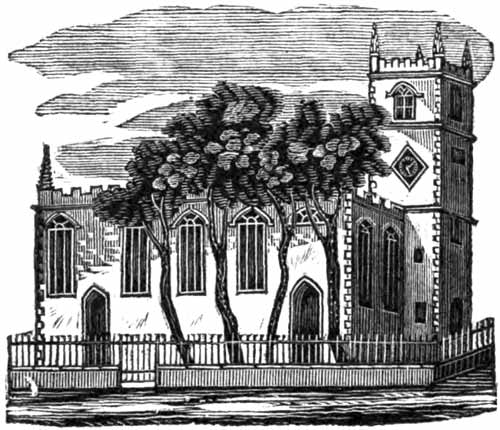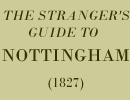< Previous | Contents | Next >
Proceeding down Wheeler-gate we come to the
OBELISK,
a stone column erected in the year 1787, over the common sewer for a considerable part of the town, and lighted at night by a very large gas lamp. Full in view stands

ST PETER'S CHURCH,
built of stone, in the Gothic style, with a tower at the west end, supporting the only spire in the town; There are a number of trees in the church-yard, and the principal entrance is by the north side, but it is intended to make a new entrance from the obelisk, in the square. It is generally supposed this church was built at the early part of the fifteenth century, but it has been much improved of late years. There is a peal of eight bells in the steeple, said to be the best attuned and most melodious of any within many miles of Nottingham.
A peculiar neatness distinguishes the interior of this church. Here have been lately erected seven or eight hundred free seats for the use of the poor, and an organ was placed in the gallery in 1812. At the east end of the chancel is a beautiful painting by Mr. Barber, as an altar piece, representing Christ's agony in the garden.—Here is the burial place of the family of the Smiths, at the head of which is Lord Carrington, and in the chancel there are several beautiful monuments of departed members of this family.
In the south able, was formerly the chapel dedicated to St. Mary, and here the spiritual court of the archdeaconry of Nottingham has been held time immemorial. The Rector is the Rev. R. W. Almond, MA.; M. R. S. L.; and service is performed at halfpast ten and halfpast six every Sabbath.
Proceeding up Hounds'-gate, on the south side, is a small building, used for the
LANCASTRIAN GIRLS' SCHOOL,
and also as a Sunday school for the girls of the Castle-gate meeting house, and on the opposite side of the street, but retired from public view, is the
SANDEMANIAN CHAPEL,
erected in the year 1788. Service is performed on the Sabbath, at ten and two; and on Wedndsday, in the summer season at six, and in the winter season at three. The elders are Mr. John Nixon and Mr. Lewis Rigby.—Turning back by the church side, whence our view of St Peter's church is taken, we go down Church-gate, which leads us to the bottom of the Low-pavement, on the north side of which are some very good houses, and nearly in the centre is the
ASSEMBLY ROOM,
the entrance to which is by a large door, apparently into a garden, so that it makes no show on the outside, but the interior is fitted up with much taste, though it is not now so much used as formerly, the large room at the Exchange having in some measure superseded it. On the opposite side of the street is the residence of Lewis Allsopp Lowdham, Esq. with a few trees before it, and lower down is the Town Clerk's office, and lower still is the elegant residence of Thomas Wakefield, Esq, a relative of the late celebrated Gilbert Wakefield. Proceeding in a straight line, we come to Castle-gate, where are some of the best houses in the town. On the north side is
CASTLE-GATE MEETING-HOUSE
and burial-ground. This place was built in 1688, and measures fifty-five feet by fifty-three, and adjoining thereto is a vestry and two school rooms. In 1826 the meeting house was put into complete repair, and an organ placed therein. Here assemble one of the most wealthy dissenting congregations in the town, known as Calvinistic Independents. The minister is the Rev. Richard Alliott, and service is performed at a quarter to eleven and at three every Sabbath, and on Wednesday evenings at seven. On the south side of Castle-gate are the well-built mansions of William Elliott, Esq, and of Dr. Pennington; and on the same side is

ST. NICHOLAS'S CHURCH.
A number of trees shelter the sacred edifice, and the church yard is surrounded by light iron palisades, erected in 1824. The church itself is built of brick, ornamented with stone, and has a small tower. It was finished in 1678, but has undergone many improvements since that time. There are few churches which exhibit more taste than the interior of this building It has a small organ, which was put up in the year 1811. On each side of the communion table is an elegant painting, the one on the north represents the good Samaritan, and that on the south the return of the prodigal son. The present Rector is the Rev. W. J. Butler, M. A.; and there is service at a quarter to eleven and three o'clock every Sabbath. The congregation is highly respectable. A head stone, which stands against the south wall, in the churchyard, cannot be passed by unnoticed. It is to the memory of Old Tom Booth, a whitesmith, and in his day, a noted deer stealer. The inscription runs thus:—
" Here lies a marksman, who with art and skill,
" When young and strong, fat bucks and does did kill.
"Now conquered by grim death, (go reader tell it),
" He's now took leave of powder, gun, and pellet.
"A fatal dart, which in the dark did fly,
" Has laid him down, among the dead to lie.
" If any want to know the poor slave's name,
" Tis Old Tom Booth, ne'er ask from whence he came,
" He's hither sent, and surely such another
"Ne'er issued from the belly of a mother."
Our intention is only to take a glance at objects, and not to enter into a prolix description or history, we therefore pass on up Castle-gate, where nearly at the top, on the north side, is an old stone mansion, with a few trees before it, now the residence of Mr. Gill, but worthy of notice because of its being the place where the celebrated Count Tallard resided after he was taken prisoner by the no less famous Duke of Marlborough, at the battle of Blenheim, in 1704.
